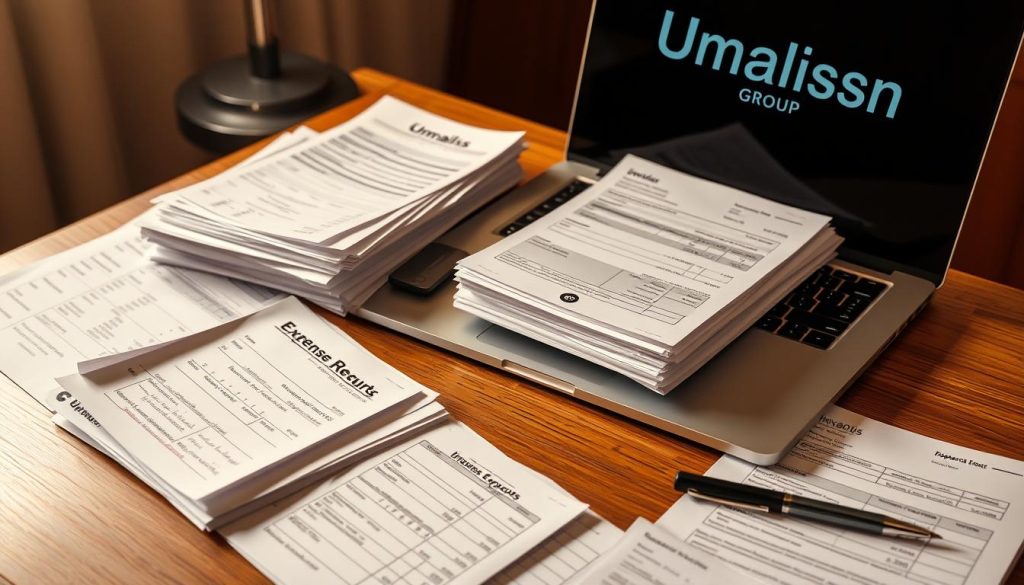While 72% of independent professionals report greater career satisfaction than traditional employees, nearly half admit they’ve lost sleep over unexpected financial obligations. The freedom of self-employment often hides a maze of administrative tasks – especially when managing earnings and compliance requirements.
Unlike salaried workers, self-employed individuals navigate three layers of complexity: calculating variable earnings, tracking deductible expenses, and understanding regional sales tax rules. One missed deadline or miscalculation can create ripple effects across your entire operation.
This guide reveals how savvy independent workers build stability through intentional financial practices. You’ll discover why reactive approaches fail and how structured systems protect both your current earnings and future growth potential.
Table of Contents
Key Takeaways
- Self-employment demands proactive financial management unlike traditional jobs
- Tracking business expenses directly impacts annual net earnings
- Regional tax obligations vary significantly for service-based professionals
- Quarterly payment systems prevent year-end financial shocks
- Strategic deductions require organized record-keeping habits
- Professional guidance reduces audit risks and maximizes savings
Overview of Freelancing and Tax Responsibilities
Independent professionals enjoy unmatched flexibility but face distinct administrative demands. Unlike traditional roles where employers handle withholdings, self-managed income requires proactive systems to maintain compliance and stability.
Compensation Structures Compared
Employees receive predictable paychecks with automatic deductions for social security and income taxes. When you’re self-employed, every payment represents gross earnings – no portion gets withheld for annual obligations. This means setting aside funds becomes your responsibility throughout the year.
Hidden Complexities of Independence
Self-managed professionals cover both individual and employer contributions for programs like CPP/QPP. One client-facing designer discovered her $75,000 income required budgeting for an extra 9.9% in contributions – a reality many overlook.
Strategic deductions offset these costs. Valid business expenses – from software subscriptions to workspace upgrades – directly reduce taxable income. Proper documentation turns routine purchases into financial advantages come reporting time.
Quarterly installments prevent year-end surprises. Once your net earnings exceed $3,000, the CRA expects prepayments based on prior-year totals. Calendar alerts and segregated savings accounts help smooth cash flow between projects.
Tax Planning for Freelancers: Understanding Taxable Income and Deductions
Self-employed professionals often discover their financial landscape contains hidden layers. While client payments flow in, not all funds remain yours to keep. Clear identification of reportable earnings separates thriving operations from those facing unexpected obligations.
Identifying Taxable Income Sources
Every payment received for services rendered qualifies as business income – whether from local clients or international partnerships. A Montreal-based translator paying Canadian rates for European projects still reports earnings based on residency, not client location.
Gross receipts ≠ net earnings. Your $80,000 project fee becomes $52,000 after subtracting valid costs. Proper categorization turns raw numbers into actionable insights:
- Service fees from all clients (domestic/foreign)
- Product sales through third-party platforms
- Reimbursements exceeding actual expenses
Maximizing Deductions and Credits
Strategic expense tracking transforms routine purchases into financial advantages. A videographer’s $4,000 equipment upgrade could reduce their taxable amount by 30%, depending on depreciation rules.
Common overlooked opportunities include:
- Workspace utilities (percentage-based calculations)
- Professional development courses
- Client acquisition costs
Pro tip: Maintain separate accounts for personal and operational funds. This simple practice clarifies deductible expenses while building audit-ready documentation.
Income, Expenses, and the Importance of Record Keeping

Clear financial visibility separates thriving independent professionals from those overwhelmed by administrative chaos. Mastering cash flow requires more than basic math – it demands systems that turn raw data into actionable insights.
Building Financial Clarity Through Documentation
Every transaction tells a story. Client payments reflect market demand, while costs reveal operational efficiency. Tools like QuickBooks or custom spreadsheets transform random numbers into strategic dashboards. As financial advisor Marie Lacroix notes: « Records aren’t just receipts – they’re the foundation of informed business decisions. »
Three essentials for sustainable tracking:
- Capture in real-time: Log income and costs daily using mobile apps or streamlined invoice templates
- Categorize precisely: Separate software subscriptions from equipment purchases
- Store securely: Use cloud backups for digital receipts alongside physical files
Small expenses create big impacts. A $12 monthly bank fee seems trivial, but $144/year becomes deductible. Over five years, that’s $720 in potential savings – enough to fund professional development courses.
Audit-proof systems require consistency, not complexity. Weekly 15-minute reviews prevent month-end scrambles. Digital tools auto-sync bank feeds, while photo-scanning apps archive paper receipts instantly. Your future self will thank you during reporting season.
Navigating Tax Filing Deadlines and Registration Requirements

Mastering calendar management transforms compliance from a stressor into a strategic advantage. Timing errors create unnecessary costs – 38% of independent professionals report penalties due to deadline confusion last year.
Understanding Filing Deadlines and Penalties
Self-employed workers enjoy extended filing windows but face stricter payment rules. While personal returns are due April 30th, you have until June 15th to file taxes for business income. However, any owed amount must reach the CRA by May 1st to avoid interest charges.
| Deadline Type | Date | Consequences |
|---|---|---|
| Payment Due | April 30 | 5% interest + 1% monthly |
| Filing Due | June 15 | 5% penalty + 1%/month (max 12%) |
| GST/HST Registration | $30k Revenue | Mandatory collection within 29 days |
When to Register for GST/HST
The $30,000 revenue threshold acts as your registration trigger. Track earnings quarterly – crossing this limit requires immediate action. One Toronto developer avoided $2,800 in penalties by automating revenue alerts through accounting software.
Proactive systems prevent registration oversights. Use digital tools to monitor income streams and forecast tax season obligations. Remember: late payments compound faster than project delays.
Essential Tax Forms for Freelancers
Navigating paperwork becomes simpler when you know which documents matter most. Proper form selection ensures accurate reporting while maximizing potential savings.
Core Documents for Different Business Structures
Sole proprietors use the T2125 form to report earnings and expenses. This attachment to your personal tax return details revenue streams and deductible costs. Those running multiple small business ventures need separate T2125s for each operation.
Industry codes add precision to filings. The CRA requires a six-digit code matching your primary service – graphic designers use 52413A, while consultants select 54121A. This classification helps authorities process submissions faster.
| Business Type | Key Form | Deadline | Details |
|---|---|---|---|
| Sole Proprietorship | T2125 + T1 | June 15 | Reports self-employment income alongside personal taxes |
| Corporation | T2 | 6 months after fiscal year-end | Requires separate corporate tax return and financial statements |
Incorporation introduces the T2 form for company filings while maintaining personal T1 submissions. This dual-system approach benefits established ventures but increases administrative work. Financial advisor Marc Bisset notes: « Most independent workers thrive as sole proprietors until hitting $150k in annual business income. »
Consider structure changes when client volume stabilizes or liability concerns grow. Quarterly consultations with accounting professionals help identify optimal transition timing without disrupting operations.
Home Office and Business Expense Deductions
Transforming your living space into a productive workspace unlocks valuable financial benefits. The key lies in understanding which costs qualify and how to calculate them accurately.
Calculating Your Workspace Allocation
Measure your dedicated area to determine expense percentages. A 140-square-foot office in a 700-square-foot apartment allows claiming 20% of shared costs. This percentage-based approach applies to:
- Utilities (electricity, water, heating)
- Rent or mortgage interest payments
- Property taxes and home insurance
Beyond the Home: Operational Costs That Count
Office supplies and professional tools often qualify for deductions. Marketing budgets, software subscriptions, and client meeting travel costs also reduce taxable income. As accountant Sophie Martin advises: « Treat every purchase as a potential deduction – then verify eligibility through CRA guidelines. »
Mixed-use expenses require careful tracking. Internet bills used 60% for work? Document usage patterns monthly. Apps like Expensify simplify splitting personal and professional costs automatically.
| Expense Type | Documentation Needed | Claim Percentage |
|---|---|---|
| Internet | 12-month usage logs | Business % |
| Vehicle | Mileage records | Work-related trips |
| Equipment | Receipts + depreciation schedule | Full cost |
Maintain organized records for six years post-filing. Digital tools create audit-ready reports while saving hours during tax season. Strategic deductions reward those who plan ahead.
Strategies for Separating Personal and Business Finances
Establishing distinct financial channels safeguards both your business growth and personal assets. Many self-employed professionals create unnecessary hurdles by blending funds—a practice that complicates expense tracking and invites scrutiny during annual filings.
Begin with dedicated accounts for all professional activities. This separation keeps client payments and operational costs isolated from personal spending. Pair this with a business credit card exclusively for work-related purchases, from software upgrades to client meetings.
Best Practices for Clean Financial Records
The system streamlines money management through automatic expense categorization and simplified invoice tracking. Financial institutions also view segregated accounts favorably when assessing credit applications.
Key strategy: Schedule automatic transfers. Allocate a percentage of each payment to your tax reserve fund. This proactive approach prevents year-end surprises while maintaining audit-ready records. Your disciplined framework protects earnings and builds credibility with both authorities and potential partners.
FAQ
How do I determine which business expenses are deductible?
Deductible expenses must be directly tied to earning self-employment income. Common examples include office supplies, software subscriptions, marketing costs, and a portion of home utilities. Always keep receipts and document the business purpose of each expense.
Can I deduct my home office if I work remotely?
Yes, if you use a workspace exclusively and regularly for business. Calculate the deduction using either the simplified method (a fixed rate per square foot) or the detailed method (based on the percentage of your home used for work).
When am I required to register for GST/HST?
You must register once your annual self-employment income exceeds ,000 CAD in a 12-month period. Freelancers below this threshold can still register voluntarily to claim input tax credits.
Why is separating personal and business finances critical?
Mixing funds complicates tracking deductible expenses and increases audit risks. Use separate bank accounts and credit cards for business transactions. Tools like QuickBooks or FreshBooks simplify categorizing payments and invoices.
What’s the difference between Form T2125 and a T1 tax return?
Form T2125 reports self-employment income and expenses, which is then included in your personal T1 return. Corporations file a T2 return separately. Both forms require detailed records of earnings and allowable deductions.
How often should I make tax payments as a freelancer?
Canada Revenue Agency (CRA) requires quarterly installments if you owe over ,000 in taxes for the year. Calculate payments using prior-year income or estimated earnings to avoid penalties.
Are professional development courses tax-deductible?
Yes, if the training directly relates to improving skills for your current business. Keep records of course fees, materials, and travel costs. Seminars unrelated to your field generally don’t qualify.
How long should I retain financial records?
The CRA requires keeping receipts, invoices, and supporting documents for six years after filing. Digital backups using cloud storage like Dropbox or Google Drive ensure easy access during audits.





